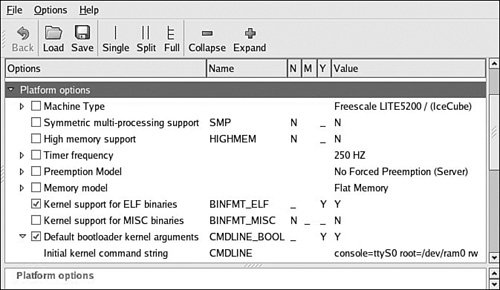Книга: Embedded Linux Primer: A Practical, Real-World Approach
16.2.3. Static Kernel Command Line
16.2.3. Static Kernel Command Line
One of the more interesting operations in the machine_init() function reproduced in Listing 16-5 is to store the default kernel command line. This operation is enabled if CONFIG_CMDLINE is enabled in your kernel configuration. On some platforms, the bootloader does not supply the kernel command line. In these cases, the kernel command line can be statically compiled into the kernel. Figure 16-2 illustrates the configuration options for this.
Figure 16-2. Default kernel command line

Enable "Default bootloader kernel arguments" in the configuration in Figure 16-2 and edit the "Initial kernel command string" as shown. This results in a set of entries in the .config file, as shown in Listing 16-6.
Listing 16-6. Configuration for Default Kernel Command Line
...
CONFIG_CMDLINE_BOOL=y
CONFIG_CMDLINE="console=ttyS0 root=/dev/ram0 rw"
...
The ellipses in Listing 16-6 indicate that we have taken only a small snippet of the .config file. When these configuration symbols are processed by the kernel build system, they become entries in the .../include/linux/autoconf.h file, as detailed in Listing 16-7.
Listing 16-7. File autoconf.h Entries for Default Kernel Command Line
...
#define CONFIG_CMDLINE_BOOL 1
#define CONFIG_CMDLINE "console=ttyS0 root=/dev/ram0 rw"
...
Now referring back to Listing 16-5, we have the following line:
strlcpy(cmd_line, CONFIG_CMDLINE, sizeof(cmd_line));
You can see that this kernel-based string-copy function copies the string defined by CONFIG_CMDLINE into a global kernel variable called cmd_line. This is important because many functions and device drivers might need to examine the kernel command line early in the boot sequence. The global variable cmd_line is hidden away at the start of the .data section, defined in the assembler file .../arch/ppc/kernel/head.S.
A subtle detail is worth mentioning here. Looking back at Listing 16-4, we see that the machine_init assembly language call is made before the call to MMU_init. That means that any code we are able to run from machine_init is executed in a context with limited support for accessing memory. Many of today's processors that contain an MMU cannot access any memory without some initial mapping via hardware registers in the processor.[108] Typically, a small amount of memory is made available at boot time to accommodate loading and decompressing the kernel and a ramdisk image. Trying to access code or data beyond these early limits will fail. Each architecture and platform might have different early limits for accessing memory. Values on the order of 8 to 16MB are not untypical. We must remember that any code we execute from machine_init, including our platform initialization, takes place in this context. If you encounter data access errors (PowerPC DSI exception[109]) while debugging your new kernel port, you should immediately suspect that you have not properly mapped the memory region your code is trying to access.
- QLineEdit
- Appendix A. Detailed explanations of special commands
- Kernel setup
- Basics of the iptables command
- Commands
- Creating CDs from the Command Line
- Using the kill Command to Control Processes
- The echo command
- Можно ли отказаться от Проводника? Мне удобнее работать с Total Commander, но Проводник все равно постоянно «висит» в па...
- Total Commander
- Kernel Address Space
- КЛЮЧЕВЫЕ СЛОВА: auto, extern, static, register




